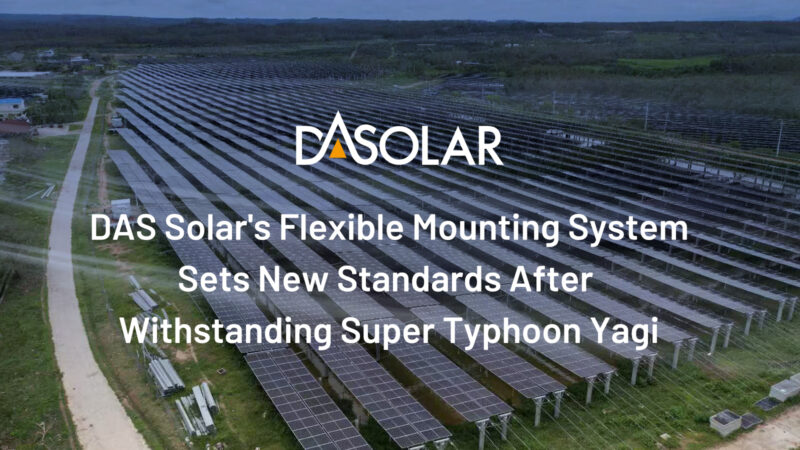PVTIME – The super typhoon Yagi recently made landfall along the coast of Wenchang, Hainan Province, with a wind speed exceeding level 17 at about 245 km/h (68 m/s), causing widespread regional impact. Meanwhile, the Hainan Ding’an Longhu fishery PV project, located just 50 kilometers from the typhoon’s landing point, remains stable and secure post-storm. Fully adopting DAS Solar’s flexible mounting system, the project validates the reliability and durability of the flexible mounting system under extreme weather conditions, setting a new quality benchmark for the industry.

Covering approximately 1,000 acres, the 70MW project was first connected to the grid in January, 2023. As the first fishery PV project in Hainan to adopt flexible mounting system, it has already withstood several extreme weather tests, including typhoons Talim and Koinu, with wind speeds surpassing level 12. The project continues to operate smoothly and provide consistent power output, further advancing local green energy development.
The outstanding performance of the project during Typhoon Yagi is the result of DAS Solar’s dedicated research and innovation in flexible mounting technology for years. The company’s independently developed new generation of flexible mounting system replaces traditional tube brackets with prestressed steel cables. The east-west direction is supported by two prestressed steel cables, while the north-south direction features a unique inter-row wind resistance system design. This creates a spatial cable-net structure across the east-west and north-south directions, effectively resisting external loads and significantly improving wind resistance performance, ensuring long-term stable operation of the power plant.
Previously, DAS Solar’s products have passed stringent wind tunnel tests organized by the internationally renowned TUV SÜD and received the organization’s first wind tunnel certification. In addtion, DAS Solar’s flexible mounting system has been validated in wind load and wind vibration response wind tunnel tests conducted by Nanjing University of Aeronautics and Astronautics. The primary research outcomes from these wind tunnel tests include wind load distribution characteristics analysis for two different scale models of flexible mounting systems and an in-depth analysis of structural wind vibration responses. Furthermore, a refined full-scale model and finite element model are developed to thoroughly analyze wind load interference effects and structural dynamic characteristics of the flexible mounting system. The studies confirm that DAS Solar’s modules and flexible mounting system remain rock solid under extreme conditions, exhibiting outstanding wind resistance, structural integrity, and long-term durability. This achievement not only sets a new benchmark for wind resistance in the industry but also provides valuable references for future PV power plant construction in typhoon-prone regions.
While ensuring product reliability and stable operation of the power plant, the project further integrates advanced fishery PV concepts, maximizing efficient land use, and promoting harmonious coexistence between the fishery and PV industries. Apart from enhancing the economic benefits for customers, the project also plays an active role in promoting positive ecological cycles, serving as a benchmark and model for green and sustainable development in Hainan and across the country.
As global climate change intensifies, the stability and reliability of PV products have become key factors in optimizing the overall resilience and operational life-cycle of solar systems. The successful implementation of DAS Solar’s Hainan fishery PV project not only demonstrates the effectiveness of DAS Solar’s flexible mounting system in harsh environments but also offers new insights for the global PV industry. Looking ahead, DAS Solar will continue to focus on product quality and technological innovation, striving to make more contributions to facilitate the renewable energy penetration and the shared target of carbon neutrality.











